Formula C2H2O2 Density 1.27 g/cm³ | Molar mass 58.04 g/mol Boiling point 51 °C | |
 | ||
Related compounds | ||
Glyoxal is an organic compound with the chemical formula OCHCHO. It is a yellow-colored liquid that evaporates to give a green-colored gas. Glyoxal is the smallest dialdehyde (two aldehyde groups). Its structure is more complicated than typically represented because the molecule hydrates and oligomerizes. It is produced industrially as a precursor to many products.
Contents
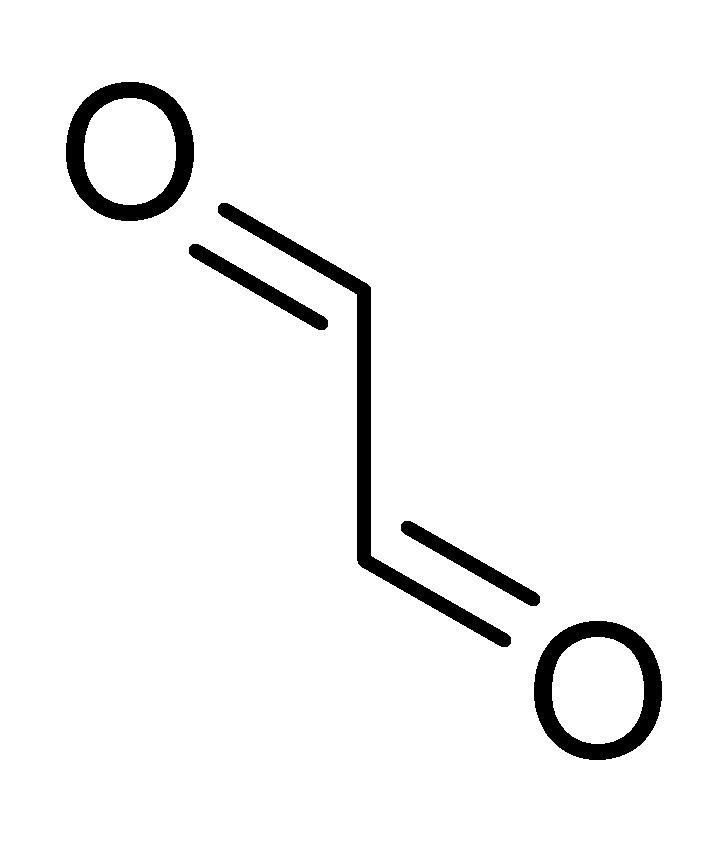
Production
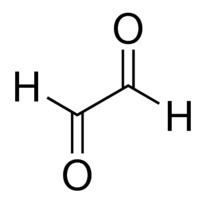
Glyoxal was first prepared and named by the German-British chemist Heinrich Debus (1824–1915) by reacting ethanol with nitric acid.
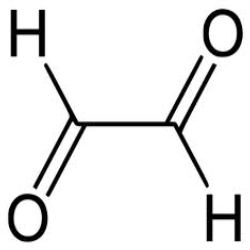
Commercial glyoxal is prepared either by the gas-phase oxidation of ethylene glycol in the presence of a silver or copper catalyst (the Laporte process) or by the liquid-phase oxidation of acetaldehyde with nitric acid. Global nameplate capacity is around 220,000 tons, with production rates less, due to overcapacity mostly in Asia. Most production is done via the gas-phase oxidation route.
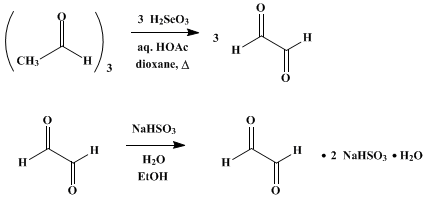
The first commercial glyoxal source was in Lamotte, France, started in 1960. The single largest commercial source is BASF in Ludwigshafen, Germany, at around 60,000 tons per year. Other production sites exist also in the US and China. Commercial bulk glyoxal is made and reported as a 40%-strength solution in water.
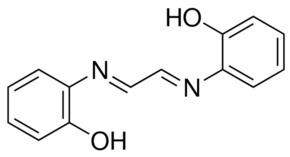
Glyoxal may be synthesized in the laboratory by oxidation of acetaldehyde with selenious acid. The preparation of anhydrous glyoxal entails heating solid glyoxal hydrate(s) with phosphorus pentoxide and condensing the vapors in a cold trap. The experimentally determined Henry's law constant of glyoxal is:
KH = 4.19 × 105 × exp[62.2 × 103/R × (1/T − 1/298)].Applications
Coated paper and textile finishes use large amounts of glyoxal as a crosslinker for starch-based formulations. It condenses with urea to afford 4,5-dihydroxy-2-imidazolidinone, which further reacts with formaldehyde to give the bis(hydroxymethyl) derivative used for wrinkle-resistant chemical treatments. It is used as a solubilizer and cross-linking agent in polymer chemistry:
Glyoxal is a valuable building block in organic synthesis, especially in the synthesis of heterocycles such as imidazoles. A convenient form of the reagent for use in the laboratory is its bis(hemiacetal) with ethylene glycol, 1,4-dioxane-2,3-diol. This compound is commercially available.
Glyoxal solutions can also be used as a fixative for histology, that is, a method of preserving cells for examining them under a microscope.
Speciation in solution
Glyoxal is supplied typically as a 40% aqueous solution. Like other small aldehydes, glyoxal forms hydrates. Furthermore, the hydrates condense to give a series of oligomers, the structures of which remain uncertain. For most applications, the exact nature of the species in solution is inconsequential. At least two hydrates of glyoxal are sold commercially:
It is estimated that, at concentrations less than 1 M, glyoxal exists predominantly as the monomer or hydrates thereof, i.e., OCHCHO, OCHCH(OH)2, or (HO)2CHCH(OH)2. At concentrations above 1 M, dimers predominate. These dimers are probably dioxolanes, with the formula [(HO)CH]2O2CHCHO. Dimer and trimer can precipitate, due to lower solubility, from solution at below 4 °C (40 °F).
Other occurrences
Glyoxal is an inflammatory compound formed when cooking oils and fats are heated to high temperatures.
Glyoxal has been observed as a trace gas in the atmosphere, e.g. as an oxidation product of hydrocarbons. Tropospheric concentrations of 0–200 ppt by volume have been reported, in polluted regions up to 1 ppb by volume.
